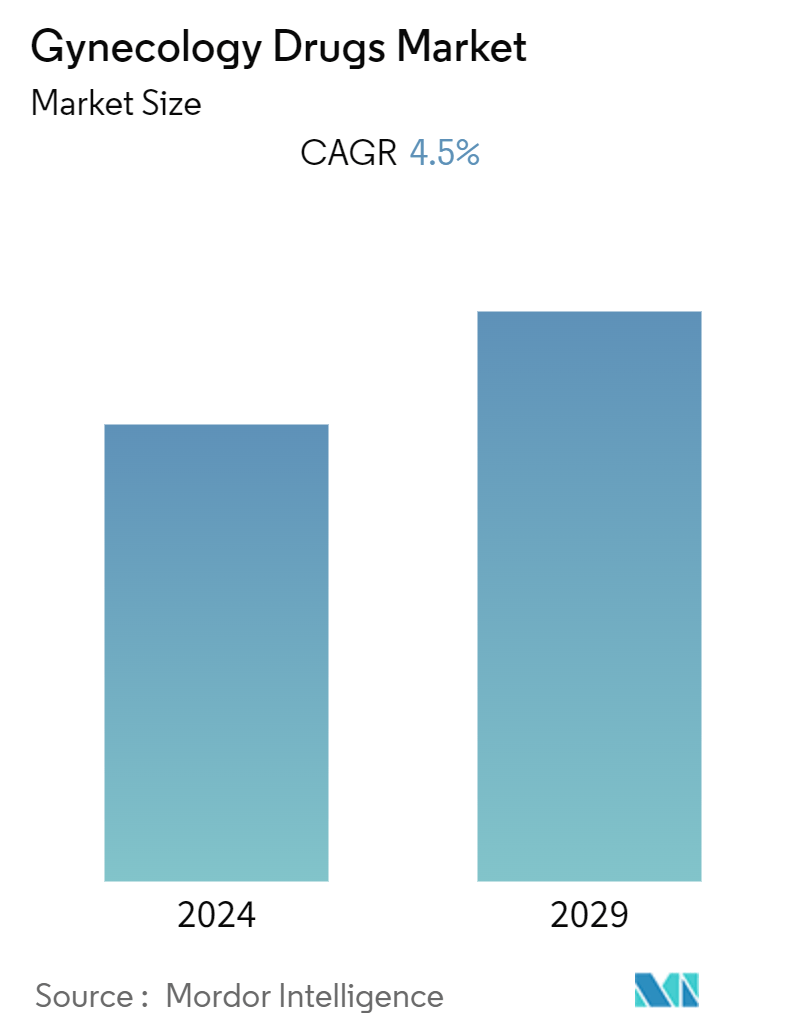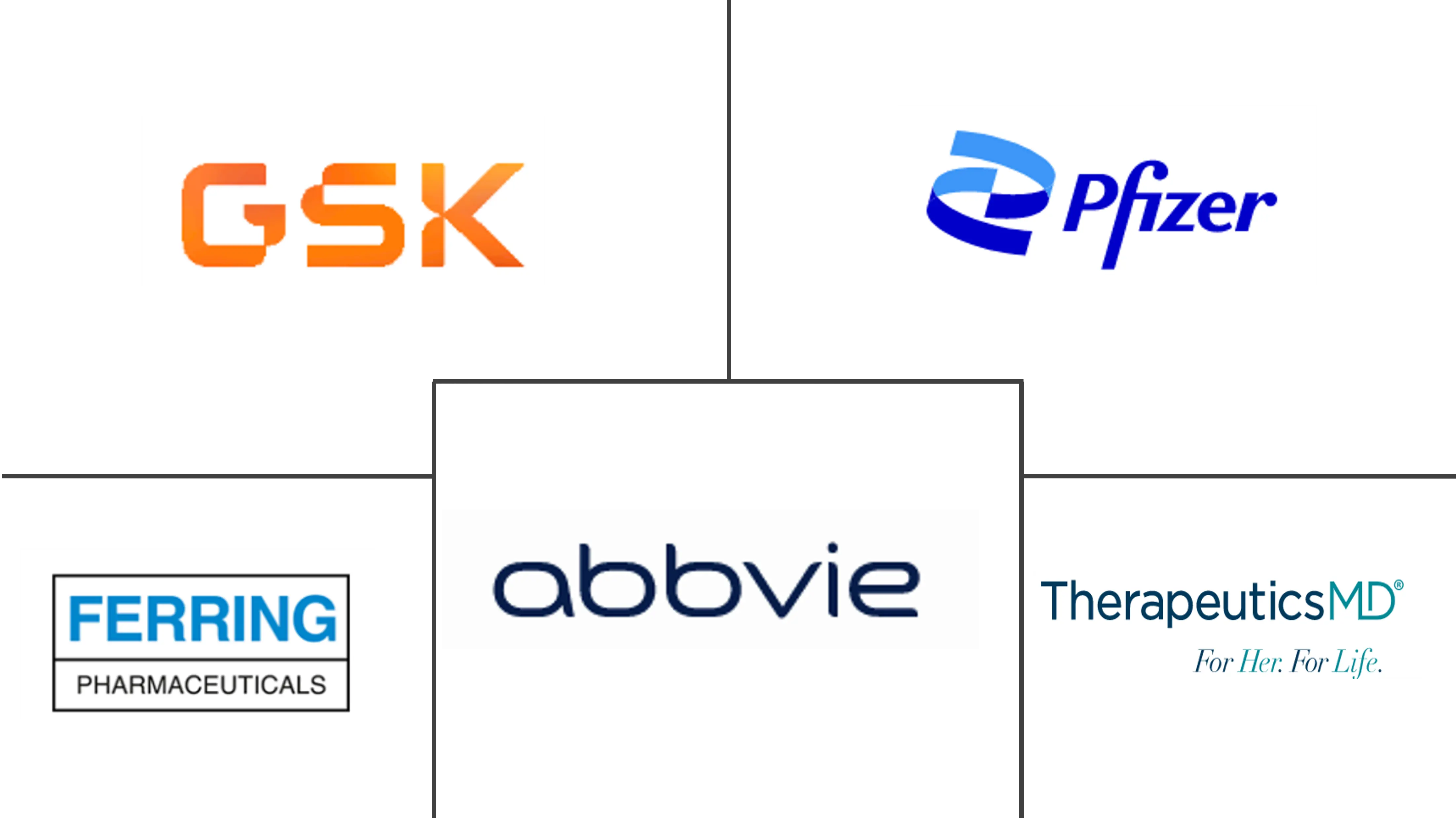Market Size of Gynecology Drugs Industry

| Study Period | 2019 - 2029 |
| Base Year For Estimation | 2023 |
| CAGR (2024 - 2029) | 4.50 % |
| Fastest Growing Market | Asia Pacific |
| Largest Market | North America |
| Market Concentration | Medium |
Major Players
*Disclaimer: Major Players sorted in no particular order |
Gynecology Drugs Market Analysis
The Gynecology Drugs Market is expected to register a CAGR of 4.5% during the forecast period.
Key growth drivers in the market under study are the escalating burden of gynecological diseases, a growing healthcare awareness, and a rising population of aging women. The increasing prevalence of conditions such as ovarian cancer, uterine fibroids, and endometriosis necessitates advanced medical interventions. Additionally, heightened awareness about women's health issues and preventive care has led to more frequent medical consultations and screenings. The aging female demographic further contributes to market growth, as older women are more susceptible to gynecological conditions, increasing the demand for healthcare services and products.
The increasing prevalence of gynecological diseases is expected to persist, spurring the need for effective treatments. This, in turn, propels the global market for gynecological drugs during the forecast period. According to the Australian Institutes of Health and Welfare, in October 2023, endometriosis accounted for 8,213 years of lived with disability (YLD) in 2023. The highest burden of this disease falls on women aged 30–34, with a rate of 1.71 YLD per 1,000 females. Notably, the YLD rate for endometriosis surged by 40% from 2003 to 2023, even after accounting for changes in the age demographic. Thus, the increasing burden of endometritis is expected to increase demand for treatment with gynecology drugs during the forecast period.
Similarly, the high prevalence of gynecology cancers is expected to propel the demand for gynecology drugs, thereby propelling the market growth. For instance, BGI Genomics 2023 Global State of Cervical Cancer Awareness Report. Cervical cancer is the fourth most common cancer among women globally, with an estimated 604,000 new cases in 2023. Further, Globocan's 2022 projections anticipate a 55% increase in global ovarian cancer diagnoses among women, reaching 503,448 by 2050. Thus, the high burden of gynecological cancer, such as cervical and ovarian cancer, is anticipated to increase the need for effective treatment, thereby boosting the market's growth.
Moreover, the rising developments by key market players also enhanced the market's growth. For instance, in April 2024, Pfizer Inc. and Genmab AS declared that the Food and Drug Administration (FDA) approved TIVDAK (nivolumab vedotin-tftv) through the supplemental Biologics License Application (sBLA). This approval is specifically for treating patients facing recurrent or metastatic cervical cancer whose condition has worsened post-chemotherapy. Similarly, in September 2022, Lynparza received approval in China as the first line of maintenance treatment with bevacizumab for homologous recombination deficiency (HRD)-positive advanced ovarian cancer.
Thus, the growing burden of gynecological diseases and gynecological cancer and product launches by the market players is expected to contribute to the market's growth during the forecast period. However, the high cost and stringent regulatory framework that delays the approval of products are likely to restrain the market's growth during the forecast period.
Gynecology Drugs Industry Segmentation
Gynecological drugs are used to treat ailments related to the female reproductive system. A major shift in the lifestyles of women led to a rise in the prevalence of gynecological disorders affecting the functioning of the uterus, ovaries, and appendages.
The gynecology drugs market is segmented by therapeutics, indication, distribution channel, and geography. By therapeutics, the market is segmented as hormonal therapy and non-hormonal therapy). By indication, the market is segmented as gynecology cancers, menopausal disorder, polycystic ovary syndrome, contraception, and other indications. By distribution channel, the market is segmented into hospital pharmacies, retail pharmacies, and online pharmacies. By geography, the market is segmented as North America, Europe, Asia-Pacific, Middle East and Africa, and South America).
The report offers the value (USD) for the above segments.
| By Therapeutics | |
| Hormonal Therapy | |
| Non-hormonal Therapy |
| By Indication | |
| Gynecology Cancers | |
| Menopausal Disorder | |
| Polycystic Ovary Syndrome | |
| Contraception | |
| Other Indications |
| By Distribution Channel | |
| Hospital Pharmacies | |
| Retail Pharmacies | |
| Online Pharmacies |
| Geography | ||||||||
| ||||||||
| ||||||||
| ||||||||
| ||||||||
|
Gynecology Drugs Market Size Summary
The gynecology drugs market is poised for significant growth over the forecast period, driven by an increasing burden of gynecological diseases and heightened healthcare awareness. The market experienced a slowdown during the COVID-19 pandemic due to resource allocation towards managing the virus, but is expected to recover as restrictions ease. The rising incidence of conditions such as polycystic ovary syndrome and gynecological cancers is anticipated to boost demand for effective treatments. Key market players are actively developing and launching new products, such as Myovant Sciences and Pfizer Inc.'s MYFEMBREE, which received FDA approval for managing heavy menstrual bleeding. However, challenges such as high costs and a stringent regulatory environment may hinder market expansion.
The non-hormonal therapy segment is expected to experience robust growth, attributed to its proven efficacy and reduced side effects compared to hormonal alternatives. Ongoing studies and clinical trials, such as Bayer's Phase III program for elinzanetant, are enhancing the understanding and application of non-hormonal therapies in treating gynecological conditions. North America is projected to hold a significant market share, supported by advanced healthcare infrastructure and a high prevalence of gynecological diseases. The region's market growth is further bolstered by government initiatives and early product launches. The competitive landscape is characterized by the presence of major players like Allergan Plc, Pfizer Inc, and AbbVie Inc, who are employing strategies such as product launches and acquisitions to strengthen their market positions.
Gynecology Drugs Market Size - Table of Contents
-
1. MARKET DYNAMICS
-
1.1 Market Overview
-
1.2 Market Drivers
-
1.2.1 Increasing Burden of Gynecological Diseases
-
1.2.2 Rise in Healthcare Awareness Along with Increasing Ageing Female Population
-
-
1.3 Market Restraints
-
1.3.1 High Costs and Stringent Regulatory Framework that Delays the Approval of the Drugs
-
-
1.4 Porter's Five Forces Analysis
-
1.4.1 Threat of New Entrants
-
1.4.2 Bargaining Power of Buyers/Consumers
-
1.4.3 Bargaining Power of Suppliers
-
1.4.4 Threat of Substitute Products
-
1.4.5 Intensity of Competitive Rivalry
-
-
-
2. MARKET SEGMENTATION (Market Size by Value - USD)
-
2.1 By Therapeutics
-
2.1.1 Hormonal Therapy
-
2.1.2 Non-hormonal Therapy
-
-
2.2 By Indication
-
2.2.1 Gynecology Cancers
-
2.2.2 Menopausal Disorder
-
2.2.3 Polycystic Ovary Syndrome
-
2.2.4 Contraception
-
2.2.5 Other Indications
-
-
2.3 By Distribution Channel
-
2.3.1 Hospital Pharmacies
-
2.3.2 Retail Pharmacies
-
2.3.3 Online Pharmacies
-
-
2.4 Geography
-
2.4.1 North America
-
2.4.1.1 United States
-
2.4.1.2 Canada
-
2.4.1.3 Mexico
-
-
2.4.2 Europe
-
2.4.2.1 Germany
-
2.4.2.2 United Kingdom
-
2.4.2.3 France
-
2.4.2.4 Italy
-
2.4.2.5 Spain
-
2.4.2.6 Rest of Europe
-
-
2.4.3 Asia-Pacific
-
2.4.3.1 China
-
2.4.3.2 Japan
-
2.4.3.3 India
-
2.4.3.4 Australia
-
2.4.3.5 South Korea
-
2.4.3.6 Rest of Asia-Pacific
-
-
2.4.4 Middle East and Africa
-
2.4.4.1 GCC
-
2.4.4.2 South Africa
-
2.4.4.3 Rest of Middle East and Africa
-
-
2.4.5 South America
-
2.4.5.1 Brazil
-
2.4.5.2 Argentina
-
2.4.5.3 Rest of South America
-
-
-
Gynecology Drugs Market Size FAQs
What is the current Gynecology Drugs Market size?
The Gynecology Drugs Market is projected to register a CAGR of 4.5% during the forecast period (2024-2029)
Who are the key players in Gynecology Drugs Market?
Ferring Holding SA, TherapeuticsMD Inc., AbbVie Inc., Pfizer Inc. and GSK plc are the major companies operating in the Gynecology Drugs Market.

